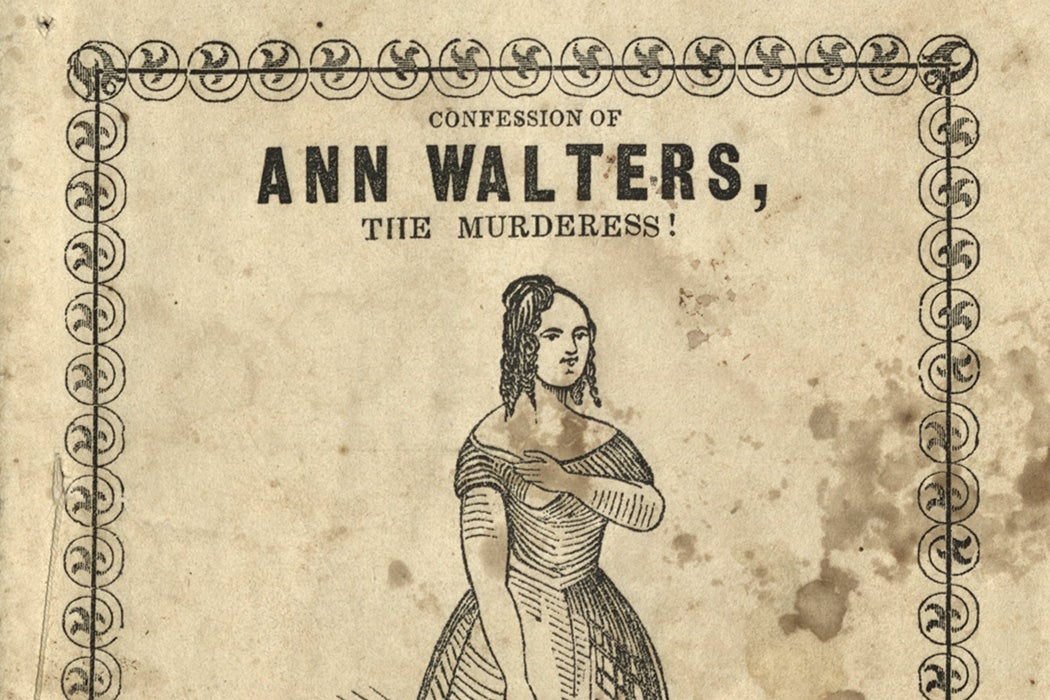Antebellum literature was all retiring women and timorous love, right? Wrong. In the 1840s and 1850s, two little-remembered publishers created a new genre about husband- or lover-murdering “female fiends.” The ghastly trend pushed against the romantic stereotypes of the nineteenth century—and, writes literary scholar Dawn Keetley, even anticipated future arguments about women’s rights, marriage, and love.
The “relatively unknown literary form” was mostly the work of publishers Erastsus Elmer Barclay and Arthur Orton, writes Keetley. Packed with sensational illustrations of beautiful women poised to kill, the books gripped readers in exchange for just a few pennies. Their titles, like Narrative and Confessions of Lucretia P. Cannon … Containing an Account of Some of the Most Horrible and Shocking Murders and Life and Confession of Ann Walters, the Female Murderess! promised thrills, chills, and plenty of drama.
It’s a genre with conventions of its own: a beautiful white heroine who murders her man, then embarks on a crime spree, “indulging in everything from sexual promiscuity, drinking, gambling, and dressing as a man to counterfeiting, robbery, infanticide, and serial murder.” Dime novels weren’t a thing yet—the stories were printed in pamphlets and sold by traveling salesmen. Keetley thinks they were mainly read by middle-class women. Since the stories masqueraded as morality plays, they were seen as appropriate for women readers.
But inside their cheap covers, these fiendish tales challenged conventional morality and even marriage. Their often-married heroines rained down horror on their “generally worthless” husbands, and contributed to a nascent debate about the nature of antebellum marriage. At the time, women could not obtain divorces in most states. If they married a man who was violent or intemperate, their only option was to grit their teeth and bear it. The stories explore what Keetley calls “an intense anxiety about the eruption of violence within marriage”—a circumstance women simply could not escape.
The fictional fiends, however, did. The heroine of Isabella Narvaez, for example, tries to reform her alcoholic, gambling-addicted husband. So she poisons him, tricking him into taking the poison himself. Like other fiends of the genre, Isabella has what Keetley calls “a core lust for unfettered freedom”—a desire likely shared by the socially corseted women who read her story.
Weekly Newsletter
For Keetley, the pamphlets are a breeding ground for debates and tests of emerging concepts of companionate marriage and female independence. She cites the era’s tussle over whether women should be able to own their own property or be legally able to divorce, a controversy taken up by influential figures like the editor Horace Greeley, who publicly objected to divorce, even in the case of abuse or adultery. Greeley and others felt that marriage was the only thing that could contain women’s wild sexual passions, but the fiendish heroines of the cheap books proved that marriage wasn’t enough to rein in female lust.
At the time, notes Keetley, a few radical women claimed that marriages that couldn’t be dissolved produced dangerous societal ills. The stories of “fiendish females” anticipated those arguments—and arguably sowed the seeds of discontent and fear about nineteenth-century marriage.







